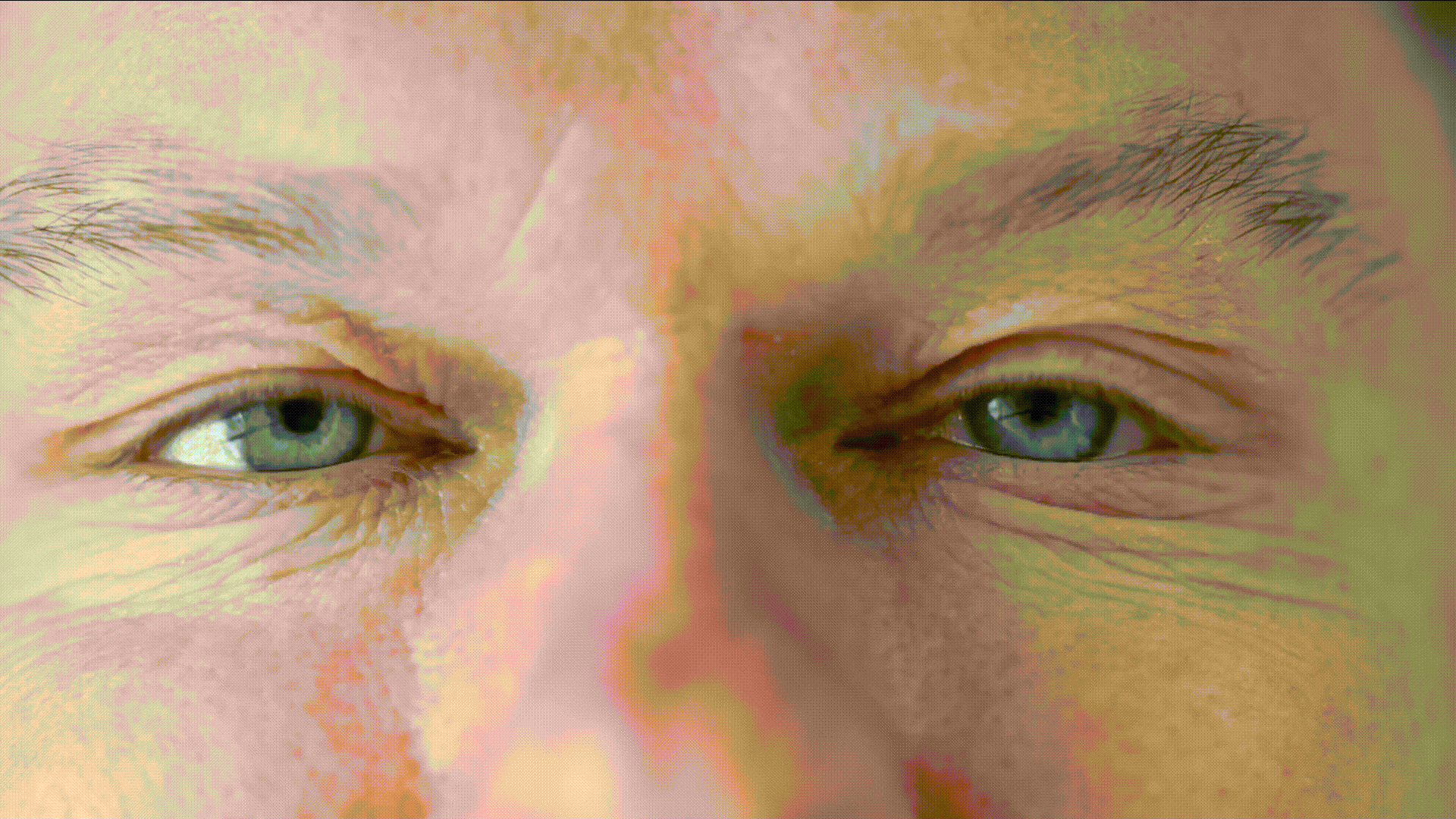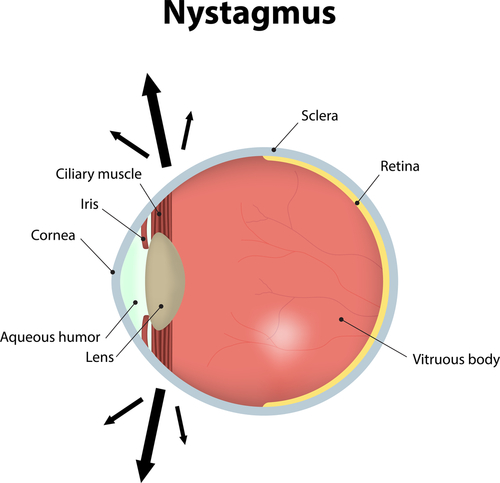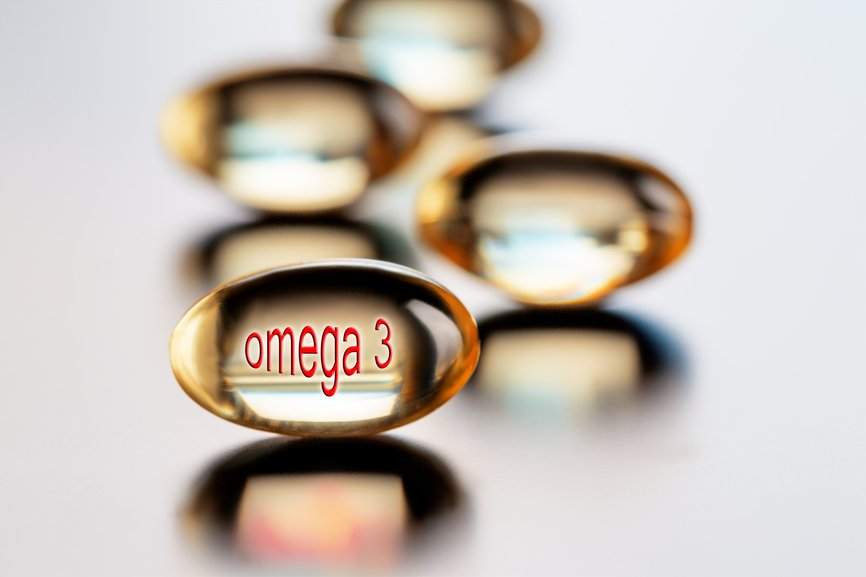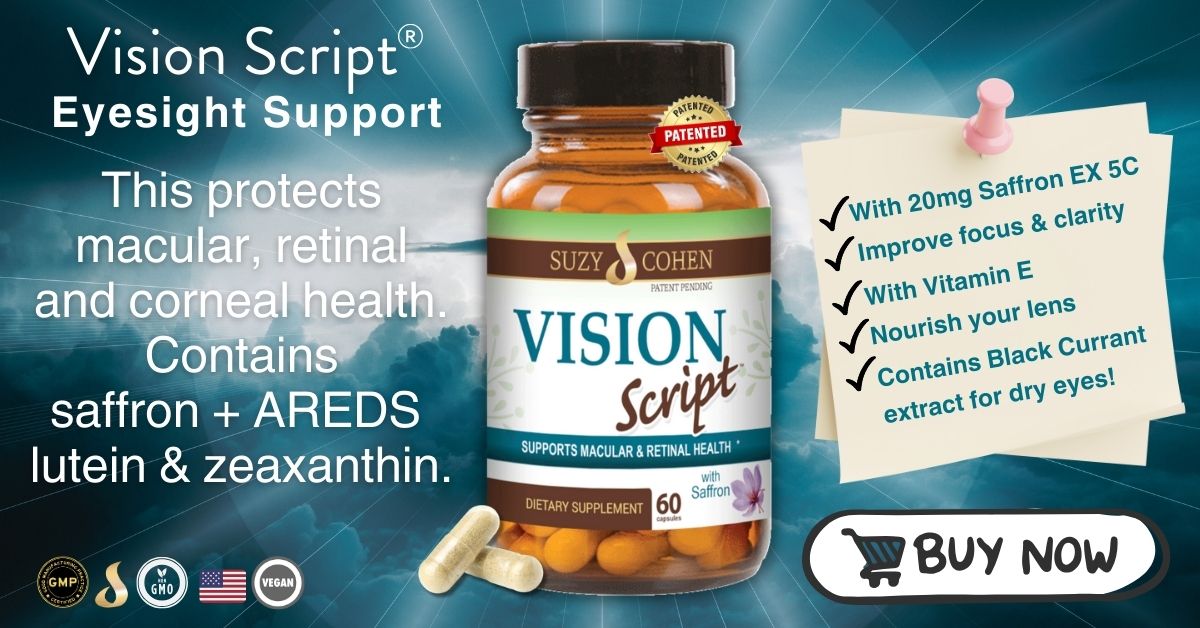What's On This Page?
ToggleImagine a pair of dancing eyes, but this little dance isn’t voluntary. It’s a condition where the eyes make repetitive, uncontrolled movements, either side to side, up and down, or in a circular pattern. The most common type is called “downbeat” nystagmus and it’s when the eyes oscillate up and down. People with this commonly present with a couple of other symptoms such as an unsteady gait, and vertigo.
The eye condition is termed nystagmus and is often dubbed “dancing eyes” since it involves these involuntary, rhythmic movements of the eyes.

Whether you’re a curious reader, someone who has experienced these intriguing eye movements, or a loved one seeking answers, let’s embark on a journey to learn more about this condition which affects more people than you think!
The disorder will obviously cause vision issues and in my opinion, it’s a sign or symptom it’s not a disease itself. It rarely occurs by itself, but more often occurs as the result of some other health concern.

Nystagmus can cause blurry vision and difficulty with depth perception. Imagine trying to catch a ball and it always seems just a tad closer (or further) than it really is. The idea of catching a ball made me think of our lovely furry friends – dogs!
Did you know they can also develop nystagmus? I’m not a vet, however, my understanding is that in dogs, it’s usually tied to an inner ear problem. So if your furball looks like he’s giving you Morse code winks, take it to a veterinarian.
Statistics and Prevalence of Nystagmus
Nystagmus affects approximately 1 in 1,000 people. It can be present at birth or develop later in life. According to the American Optometric Association, the congenital sort usually becomes apparent between the first 3 to 6 months of age.
Nystagmus can be categorized into two primary types: Congenital (or infantile) , which is present at birth or develops within the first six months of life and acquired nystagmus, which can occur later in life due to various causes such as medications, a stroke, or Multiple Sclerosis. See below where I’ve listed various causes for both types.
According to the National Eye Institute, congenital nystagmus is estimated to affect 2 to 3 out of every 10,000 children in the United States. The acquired type is less common, and its prevalence is not as well documented, but it’s believed to increase with age, particularly in individuals over 60. When I worked in long-term care facilities, nystagmus was a common side effect of taking certain PSYCHOTROPIC medications.
What Causes the Eye Movements?
Congenital Nystagmus
Albinism: Individuals with albinism often have abnormal development of the retina and abnormal nerve connections to the brain, which can lead to ‘shaky’ eyes.
Incomplete Development of the Eye or its Nerve Connections: This can be due to various genetic conditions or can occur spontaneously without a clear cause.
Congenital Eye Conditions: Conditions like cataracts, strabismus, or retinopathy of prematurity can also cause nystagmus if present from birth.

Acquired Nystagmus
Medications and Drugs: Certain medications, especially those affecting the central nervous system like anti-epileptics or sedatives, as well as excessive alcohol consumption, can cause nystagmus.
Inner Ear Disorders: The inner ear plays a significant role in balance, and conditions like Meniere’s disease affecting the inner ear can cause wobbly eyes.
Multiple Sclerosis: This autoimmune condition that affects the brain and spinal cord can cause lesions in areas that control eye movements, leading to nystagmus.
Stroke: A stroke can affect the areas of the brain that control eye movements, and involuntary movements of the eyes can be one of the manifestations.
Head Injury: Trauma to the head can cause damage to the structures controlling eye movements.
Vitamin Deficiencies: Deficiencies, especially of Vitamin B12 and thiamine, can affect the nervous system and lead to nystagmus. There are so many drug muggers of these B vitamins, probably hundreds! 
Tumors or Lesions in the Brain: Any mass effect or damage to the parts of the brain that control eye movements can cause lead to the condition.
Wernicke’s Encephalopathy: This is usually caused by severe thiamine deficiency, often seen with chronic alcohol consumption. It easily leads to all kinds of neurological symptoms including nystagmus.
Lyme Disease: Lyme disease is an infection that’s caused by Borrelia burgdorferi, which is transmitted through the bite of infected ticks. This infection can -and often does- affect the central nervous system, leading to a condition known as neuroborreliosis.
When the bacteria invade the brain and spinal cord, it can cause various neurological symptoms including meningitis, facial palsy, and in rare cases, nystagmus or other eye movement disorders.
It’s important to recognize that nystagmus is not a disease in itself, but rather a symptom that can be associated with a variety of underlying conditions or factors. As such, management and treatment of the problems depend on identifying and addressing their underlying cause.
If someone is experiencing symptoms of nystagmus, it’s advisable to consult a healthcare professional for a thorough evaluation.
Small Fiber Neuropathy: SFN mainly affects the small sensory fibers and autonomic fibers of the peripheral nervous system. It can cause pain, burning, and numbness in your hands and feet, in some cases, it is associated with autonomic dysfunction. In rare instances, SFN impacts the control of eye movements and causes nystagmus. However, SFN causing nystagmus would not occur by itself, it would be one of many other symptoms and problems with the neurological system. You can read my article Small Fiber Neuropathy Causes and Treatment.
Now let’s don those lab coats and take a look at some of the medications associated with the development of nystagmus.

Here are the most common drug offenders:
Phenytoin (Dilantin) – commonly used for seizures
Lithium – a mood stabilizer
Anti-anxiety meds such as Alprazolam (Xanax)
Anti-vertigo medication like Meclizine
Carbamazepine, used for epilepsy and neuropathic pain
Barbiturates, such as Phenobarbital
Baclofen, a muscle relaxant
Gabapentin and Pregabalin, used for nerve pain
Certain antidepressants like Amitriptyline
Antipsychotics like Thioridazine
Opiates like Morphine
Excessive alcohol consumption
If you’re taking one of these meds and your eyes start doing the cha-cha, make sure to talk to your doctor!
Now, let’s get into the nitty-gritty. What can be done to treat nystagmus?
Researchers at the University of Leicester made a breakthrough in the understanding of the cause and potential treatments for nystagmus. They discovered that a drug called 4-aminopyridine (4AP) can help reduce eye oscillations. Isn’t that amazing? Here’s one PAPER about it.
Natural Remedies and Supplements:
Let’s wander into Mother Nature’s pharmacy. It’s important to note that while herbal remedies and supplements might be natural, they should still be used with caution and in consultation with a healthcare provider.

Ginkgo Biloba: Some studies suggest that Ginkgo Biloba might help improve vision in individuals with nystagmus by increasing blood flow to the eyes. I put this ingredient in my Vision Script Eye Support Formula.
Omega-3 Fatty Acids: Omega-3 fatty acids, found in fish oils, might have potential benefits for eye health. They help in reducing inflammation* which may be especially useful if the involuntary eye movements are secondary to an autoimmune condition.
Vitamin B12: Deficiency of Vitamin B12 can lead to various eye problems, including nystagmus. In such cases, supplementing with B12 may prove helpful. You may be interested in my mitochondrial-loving B complex which contains a biologically active form of B12 and is mitochondrial-loving. Check out Mito B complex. You can shop with anyone you like, I’d just like to make this one point: If you consume beer and alcohol recreationally, then you’re naturally deficient in B vitamins (which increase risk), I’d suggest you take a high-quality B vitamin, even if it’s not mine.
Magnesium: It plays a vital role in maintaining normal muscle and nerve function. Since nystagmus involves the involuntary movement of eye muscles, ensuring an adequate intake of MAGNESIUM that penetrates the brain and eye tissue may be beneficial.
Passionflower: Some herbalists suggest that extracts from the passionflower plant can be calming to the nervous system, which may indirectly benefit those with nystagmus. This is in my Sleep Script Tranquility Capsules, along with Chamomile which I will discuss next.
Chamomile Tea: This is widely known for its calming effects and can be used as a complementary approach to relax the eyes and potentially reduce stress-induced exacerbations of nystagmus.
Remember, it’s always best to have a chat with your healthcare practitioner before starting any new supplements or natural remedies, especially if you are on medications that can interact with them. Keep those eyes happy and healthy!
Here’s Where You Go for Help
Nystagmus can be a challenging condition, and it’s essential for those affected to work closely with their healthcare providers to find the most appropriate management and treatment options.
Your initial step should be consulting your primary care physician. However, you may want a second opinion (and I suggest that) from a doctor who sees the condition more frequently. For that reason, consider the following specialized practitioners:
Ophthalmologists: They specialize in the eyes, and handle all kinds of medical and surgical eye conditions and diseases. They are skilled in diagnosing eye disorders like nystagmus and can help you navigate through all the appropriate treatment options.
 Neurologists: Since ‘dancing eyes’ can be related to the nervous system, particularly in cases of acquired nystagmus, consulting a neurologist is essential. As you know, these doctors specialize in disorders of the central and peripheral nervous system and can help identify underlying neurological conditions that are either causing or contributing to eye wobbles!
Neurologists: Since ‘dancing eyes’ can be related to the nervous system, particularly in cases of acquired nystagmus, consulting a neurologist is essential. As you know, these doctors specialize in disorders of the central and peripheral nervous system and can help identify underlying neurological conditions that are either causing or contributing to eye wobbles!
Pediatric Ophthalmologists: In cases where a child is affected, visit a pediatric ophthalmologist. These doctors specialize in diagnosing and treating eye conditions in infants and children, and it can be very helpful.
Optometrists: They make your eyeglasses so you can see with clarity. I think they can be involved in your initial assessment of visual symptoms, however, you should see an ophthalmologist for a complete evaluation and medical management.
Here are some resources and organizations with lots of information
American Nystagmus Network (ANN): This is a non-profit organization that provides support and information to people affected by the condition. It’s a wonderful community for sharing experiences and gaining insight into living with the condition.
National Eye Institute (NEI): This is a part of the U.S. National Institutes of Health, and it provides extensive information about various eye conditions, including nystagmus. It’s an excellent resource for understanding the medical aspects of the condition.
American Academy of Ophthalmology: This professional medical association provides patient education materials and resources about eye conditions.
Online Forums and Support Groups: Websites like Reddit, Facebook, and others often have groups or forums where individuals can share experiences and offer support.
Vision Rehabilitation Services: For individuals who have significant vision impairment due to nystagmus, vision rehabilitation services can help in adapting to vision loss and improving quality of life.
Summary
Nystagmus is a condition characterized by involuntary, rhythmic movements of the eyes. It can either be congenital, appearing within the first few months of life, or acquired later on. Approximately 1 in 1,000 individuals are affected, with 2 to 3 out of every 10,000 children in the United States experiencing congenital nystagmus. The condition can result in blurry vision and altered depth perception.
I mentioned this earlier, but I want to reiterate that nystagmus is not a disease in itself, but rather a symptom that can be associated with many diseases. It can also be a drug-related adverse reaction. As such, and this is critical to understand, the management and treatment of nystagmus depend 100% on your ability to identify and address the root cause. If one doctor can’t help you, find another.
My point is you should consult all your health professionals, and be persistent. Don’t accept “this is your life and learn to live with it” comments. That just means they don’t know what else to test for.
If you are someone is experiencing symptoms of nystagmus, it’s advisable to consult at least two practitioners to get two opinions and a more thorough evaluation. It’s crucial to find out the actual cause of the problem, and that way you’ll be getting the best most targeted therapy for your specific problem. Until next time, keep those peepers healthy and keep an “eye” out for each other!

Suzy Cohen, has been a licensed pharmacist for over 30 years and believes the best approach to chronic illness is a combination of natural medicine and conventional. She founded her own dietary supplement company specializing in custom-formulas, some of which have patents. With a special focus on functional medicine, thyroid health and drug nutrient depletion, Suzy is the author of several related books including Thyroid Healthy, Drug Muggers, Diabetes Without Drugs, and a nationally syndicated column.


